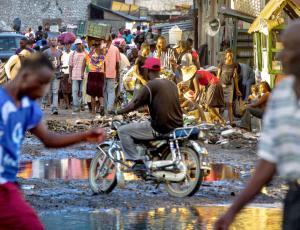News Information
- NEWS_POSTED_BY: Marcel Wah
- NEWS_POSTED_ON: Jan 05, 2015
- Views : 691
- Category : Haiti News
-
Description :
Photo: MIKE SIEGEL / THE SEATTLE TIMES
A typical street scene in Cap-Haïtien illustrates the lack of infrastructure in Haiti’s second largest city, which was spared by the earthquake. Nonprofits and the U.S. government have been trying to make this region’s economy self-sustaining, with mixed results.
By Ángel González
Seattle Times business reporterIt’s been half a decade since a 7.0 earthquake ravaged Haiti, and a tiny northern fishing village has its first electricity, illuminating both the nation’s recovery and the obstacles slowing its progress.
- Location : Haiti
- Phone : 206-464-2250
- Email : agonzalez@seattletimes.com
- Website : http://seattletimes.com/flatpages/local/haiti-part-1-earthquake-five-years-later-anniversary.html
Overview
MADRAS, Haiti — The village of Madras lies at the end of a dusty road in a forgotten corner of Haiti’s northeastern plains, not far from where Christopher Columbus is thought to have established the first European settlement in the “New World” in 1492.
Most of its inhabitants have long lived in a way Columbus would have found familiar: gathering salt and small fish to dry in the sun, and relying on oil lamps for light.
Last summer the town got its first electricity, thanks to an $18 million, U.S.-financed power plant built to feed the nearby Caracol Industrial Park — an ambitious and still-unfulfilled effort to turn Haiti’s impoverished north into a hub of industry.
Now Madras is one of the few places in Haiti with reliable, 24-7 power. Not even the impoverished nation’s sprawling capital, Port-au-Prince, has that luxury. Fourteen households in this town of about 85 families have signed up for it.
“Before electricity, we needed to go to bed early,” said Abraham Jaclaire, a gaunt but neatly dressed fisherman, as a French rap song thumped on big loudspeakers nearby.
“Now we have music, entertainment, cold drinks. We go to sleep at midnight.”
The power plant and industrial park are examples of the international community’s drive to not just repair but reinvent Haiti’s economy after the Jan. 12, 2010, earthquake that killed more than 200,000 people and devastated what was already the poorest country in the Americas. They illustrate how that effort has resulted in much progress — but also how much more needs to be done.
In the aftermath of the 7.0 quake, donors pledged $16 billion in funding through 2020. The $9.5 billion disbursed in the first two years was three times the Haitian government’s revenue in that same period, but some critics say that only a fraction ended up in Haitian hands.
While the flood of money was key in helping Haiti overcome the worst disaster in its history, the country remains more fragile than any other in the hemisphere.
